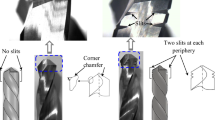Abstract
In this paper, the process of drilling inner blind hole on deep hole is simulated in the finite element software ANSYS, which can directly reflect the different influence of the cutting force on the bit when drilling. According to the result, designed a deep hole inner blind hole processing auto-device, introduce the design concept and working principle of the device, establish the design model and the mechanical model of the drill bit. Carry out several technical experiments, proved the processing feasibility of the intelligent device; analyzed the problems occurred in processing and the factors that affect machining precision. With experiment results, put forward several deficiencies and improvements for intelligent device, provide important data for future improvement.










Similar content being viewed by others
References
Gao, C. H., Cheng, K., & Kirkwood, D. (2000). The investigation on the machining process of BTA deep holedrilling. Journal of Materials Processing Technology, 107, 222–227.
Alexander, F. Casing perforating gun. U.S. Patent No. 2,192,591. March 5, 1940.
Hakala, J. Perforating gun. U.S. Patent No. 3,739,723. June 19, 1973.
Pu, L. G., & Ji, M. G. (2006). Design of machinery. Beijing: Higher Education Press.
Ramulu, M., Branson, T., & Kim, D. (2001). A study on the drilling of composite and titanium stacks. Composite Structures, 54, 67–77.
Wang, T., & Liu, Z. (2010). Study on technology of drilling superfine deep-hole in 2Cr13. Advaced Materials Research, 139-141(10), 809–812.
Liu, Y., Wang, T., & Fu, Q. (2011). Study on drilling method of small diameter deep-hole of titanium alloy by using DF of gun drill. Materials Science Forum, 10, 335–338.
Chen, R. Y. (2002). Metal cutting principles. Beijing: China Machine Press.
Raj, R., Clifford, B., Anand Ronald, B., Velayudham, A., & Nayak, P. K. (2014). Hole accuracy during deep hole drilling for hydraulic cylinder application. Advanced Materials Research, 984-985, 67–72.
Guo, Y. S., Zhang, Y., Cheng, M. K. (2014). Structural optimization of drilling bed for deep hole drilling machine. Applied Mechanics and Materials, 599–601, 473–477. Frontiers of Manufacturing Science and Measuring Technology IV.
Hayajneh, M. T. (2001). Hole quality in deep hole drilling. Materials and Manufacturing Processes, 16(2), 147–164.
Hou, X. Y., Fang, Z. D., Deng, X. Z., Cai, X. W., & Ning, C. F. (2015). Contact analysis of spiral bevel gears based on finite element model. Journal of Harbin Engineering University, 36(6), 826–830.
Author information
Authors and Affiliations
Corresponding author
Rights and permissions
About this article
Cite this article
Wang, T., Liu, X., Liu, Z. et al. ANSYS is Used on Drilling Inner Blind Hole on Deep Hole. Wireless Pers Commun 103, 1077–1088 (2018). https://doi.org/10.1007/s11277-018-5497-8
Published:
Issue Date:
DOI: https://doi.org/10.1007/s11277-018-5497-8




